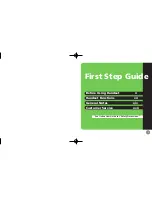
Section 4: Safety Guidelines and Warranty Information
200 4A: Safety
Antenna RF Emission Safety: Rules, Procedures, and Practical Guidance.
This Guide can be accessed at:
http://www.fcc.gov/oet/rfsafety
.
12. Who regulates exposure to radiation from microwave ovens,
television sets and computer monitors?
The Food and Drug Administration is responsible for protecting the
public from harmful radiation emissions from these consumer products.
13. Does the FCC routinely monitor radiofrequency radiation from
antennas?
The FCC does not have the resources or the personnel to routinely
monitor the emissions for all the thousands of transmitters that are
subject to FCC jurisdiction. However, the FCC does have measurement
instrumentation for evaluating RF levels in areas that may be accessible
to the public or to workers. If there is evidence for potential non-
compliance with FCC exposure guidelines for a FCC-regulated facility,
staff from the FCC’s Office of Engineering and Technology or the FCC
Enforcement Bureau can conduct and investigation, and, if appropriate,
perform actual measurements. Circumstances that could give rise to a
concern about an facility’s conformance with FCC regulations can be
found in A Local Government Official’s Guide to Transmitting Antenna
RF Emission Safety: Rules, Procedures, and Practical Guidance. This
Guide can be accessed at:
http://www.fcc.gov/oet/rfsafety
. Potential
exposure problems should be brought to the FCC’s attention by
contacting the FCC RF Safety Program at: 202-418-2464 or by e-mail:
.
14. Does the FCC maintain a database that includes information on
the location and technical parameters of all the transmitting
towers it regulates?
Each of the FCC Bureaus maintains its own licensing database system for
the service(s) it regulates (e.g., television, cellular service, satellite earth
stations.) The FCC issues two types of licenses: site specific and market
based. In the case of site specific licensed facilities, technical operating
information is collected from the licensee as part of the licensing process.
However, in the case of market based licensing (e.g., PCS, cellular), the
licensee is granted the authority to operate a radio communications
system in a geographic area using as many facilities as are required, and
Summary of Contents for SH-P300
Page 1: ...Online User s Guide Single Band PCS Phone Model SH P300 ...
Page 9: ......
Page 11: ...2 ...
Page 13: ...4 ...
Page 14: ...Section 1 5 Getting Started Section 1 Getting Started ...
Page 15: ...6 ...
Page 20: ...Section 2 11 Understanding Your Phone Section 2 Understanding Your Phone ...
Page 21: ...12 ...
Page 81: ...Section 2 Understanding Your Phone 72 2F Managing Call History ...
Page 123: ...Section 2 Understanding Your Phone 114 2H Personal Organizer ...
Page 149: ...Section 2 Understanding Your Phone 140 2J E mail ...
Page 150: ...Section 3 141 Using PCS Service Features Section 3 Using PCS Service Features ...
Page 151: ...142 ...
Page 185: ...Section 3 Using PCS Service Features 176 3B PCS Vision ...
Page 189: ...Section 3 Using PCS Service Features 180 3C PCS Voice Command ...
Page 191: ...182 ...
Page 224: ...215 ...
Page 235: ......
Page 237: ...2 ...
Page 239: ...4 ...
Page 240: ...Sección 1 5 Cómo empezar Sección 1 Cómo empezar ...
Page 241: ...6 ...
Page 246: ...Sección 2 11 Familiarícese con su teléfono Sección 2 Familiarícese con su teléfono ...
Page 247: ...12 ...
Page 307: ...Sección 2 Familiarícese con su teléfono 72 2F Registros de llamadas ...
Page 349: ...Sección 2 Familiarícese con su teléfono 114 2H Organizador personal ...
Page 375: ...Sección 2 Familiarícese con su teléfono 140 2J E mail ...
Page 377: ...142 ...
Page 411: ...Sección 3 Cómo usar las funciones del servicio PCS 176 3B PCS Vision ...
Page 415: ...Sección 3 Cómo usar las funciones del servicio PCS 180 3C PCS Voice Command ...
Page 417: ...182 ...
Page 452: ...Sección 4 Pautas de seguridad e información de garantía 217 4B Garantía limitada al cliente ...
















































